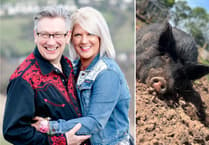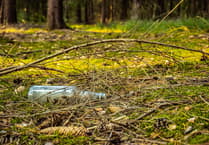You’ve moved into your lovely new home and indoors is sorted. Now you’re looking at your garden. On the surface it’s neat and tidy but it is devoid of life. Wildlife needs water, food, soil, places to breed and shelter.
It can be daunting to make a garden on a new site. The top soil gets moved before construction and heavy machinery will have compacted the sub-soil. Often not enough good soil is put back. You may have poor drainage and a lawn that holds puddles.
A boggy place in the lawn could be an excellent spot to dig a wildlife pond. Even a small pond can quickly bring a wealth of life, seemingly from nowhere, from frogs and newts to water boatmen and dragonflies. It may still be wise to install a pond liner and it’s important to have an easy way of topping up the pond in dry periods, e.g. from a water butt. Failing a pond, even a container of water will quickly attract insects and provide a water source for birds and other creatures.
Make a plan for your garden, identifying where you want flower beds. If the place where you want a bed is currently under astroturf or gravel, pull up a corner of the astroturf, or the landscape fabric under the gravel, and try digging with a garden fork to see what the builders have left behind. If the ground is hard and clay-like and water doesn’t easily drain away then you probably haven’t got much topsoil and possibly a lot of rubbish and rubble instead!
Ideally, you’ll dig this out before planting, then place a good layer of well-rotted manure, leaf mould or soil improver on top of the area. The worms will soon incorporate this and thus help improve the soil. You can buy bags of compost/soil improver made from garden waste from the Ross Recycling Centre.
If digging seems daunting, consider installing raised beds instead. You can buy the frames in self-assemble kits or make your own from salvaged timber. Cut away the astroturf or landscape from the area first before placing your frame. You can even place the frame directly over real lawn. Cover the grass inside with a layer of flattened cardboard, tucking it under the frame at the sides. Pile 10-15 cm of peat-free compost on top and plant into it. The grass won’t grow through and there’s no need to dig! The simplest way of all is to install some large containers.
Now you have your beds or containers, it’s time to fill them with plants that will feed insects or birds and give you year-round pleasure too. Look for the RHS Plants for Pollinators bee symbol on plant labels or visit the RHS website. Try to have something blooming at all times of the year and leave seed heads and berries for the birds over winter.
Finally, can you create some places for creatures to shelter? An attractive stack of logs offers plenty of crevices to hide in. An old tree stump creates a wonderful habitat for fungi, beetles and other insects and can be a feature in it’s own right, perhaps placed among ferns in a shady corner.
Making your own compost is a way to convert garden waste into something useful while supporting multiple lifeforms, both visible and invisible. Go carefully though- one day you may encounter a grumpy toad keeping cool in a pile you’ve left to mature, or perhaps a nesting slow worm!
For more ideas for creating a garden humming with life, visit the Wildlife Trust’s website.





Comments
This article has no comments yet. Be the first to leave a comment.